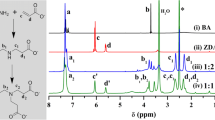Abstract
Copper phthalocyanine oligomer (CuPc) possessing high dielectric constant was grafted onto acrylic elastomer (ACM) backbones to fabricate elastomeric nanocomposites (referred to here as ACM-g-CuPc) with high dielectric constant. High strain of ACM-g-CuPc film could be achieved at low electric field. The electric field-induced strain properties of ACM-g-CuPc films were studied from four aspects: the pre-stretch value, butyl acrylate (BA) content, active region-to-window radius ratio, and strain hysteresis. The results revealed that the area strain in the active region first increased and then decreased with the increase in the pre-stretch value; however, it increased with the increase in BA content and decreased with the increase in the active region-to-window radius ratio. When the active region-to-window radius ratio was 1:5, the ACM-g-CuPc film with 60 wt% BA content and 150 × 150 % pre-stretch value exhibited the maximum area strain of 23.8 % under an electric field of 12.5 MV m−1. In a complete driving period, ACM-g-CuPc film exhibited a strain hysteresis phenomenon, forming a strain hysteresis loop.












Similar content being viewed by others
References
Brochu P, Pei QB (2010) Advances in dielectric elastomers for actuators and artificial muscles. Macromol Rapid Commu n 31:10–36
Carpi F, Kornbluh R, Sommer-Larsen P, Alici G (2011) Electroactive polymer actuators as artificial muscles: are they ready for bioinspired applications. Bioinspir Biomim 6:1–10
Pramanik B, Sahu RK, Bhaumik S (2012) Experimental study on permittivity of acrylic dielectric elastomer. In: IEEE 10th International Conference
Shankar R, Ghosh TK, Spontak RJ (2009) Mechanical and actuation behavior of electroactive nanostructured polymers. Sens Actuators A Phys 151:46–52
McCoul D, Murray C, Carlo DD, Pei QB (2013) Dielectric elastomer actuators for active microfluidic control. SPIE Smart Structures and Materials NDE
Palakodeti R, Kessler MR (2006) Influence of frequency and prestrain on the mechanical efficiency of dielectric electroactive polymer actuators. Mater Lett 60:3437–3440
Park HS, Wang QM, Zhao XH (2013) Electromechanical instability on dielectric polymer surface: Modeling and experiment. Comput Method Appl M 260:40–49
David L, Henann Shawn A, Bertoldi K (2013) Modeling of dielectric elastomers: design of actuators and energy harvesting devices. J Mech Phys Solids 61:2047–2066
Lallart M, Capsal JF, Sebald G, Cottinet PJ, Guyomar D (2014) Converse electrostrictive effect in dielectric polymers. Sens Actuators B Chem 190:259–264
Samin A, Samuel R, Herbert RS (2013) Improved electromechanical behavior in castable dielectric elastomer actuators. Appl Phys Lett 102:1–5
Li TF, Keplinger C, Baumgartner R, Bauer S (2013) Giant voltage-induced deformation in dielectric elastomers near the verge of snap-through instability. J Mech Phys Solids 61:611–628
Chouinard P, Plante JS (2013) Bistable antagonistic dielectric elastomer actuators for binary robotics and mechatronics. IEEE-ASME T Mech 17:857–865
Chakraborti P, Toprakci HK, Yang P, Di Spigna N, Franzon P, Ghosh T (2012) A compact dielectric elastomer tubular actuator for refreshable Braille displays. Sens Actuators A Phys 179:151–157
Ahmed S, Ounaies Z, Frecker M (2014) Investigating the performance and properties of dielectric elastomer actuators as a potential means to actuate origami structures. Smart Mater Struct 23:094003
Suo Z (2010) Theory of dielectric elastomers. Acta Mech Solida Sin 23:549–578
Yang J, Yang XL, Pu ZJ, Lan C, Liu XB (2013) Controllable high dielectric permittivity of poly (arylene ether nitriles)/copper phthalocyanine functional nanohybrid films via chemical interaction. Mater Lett 93:199–202
Huang C, Zhang QM (2005) Fully functionalized high-dielectric-constant nanophase polymers with high electromechanical response. Adv Mater 17:1153–1158
Liu RN, Wang JW, Li Q (2014) Copper phthalocyanine oligomer grafted acrylic elastomer nanocomposites with high dielectric constants. J Appl Polym Sci 131:6
Achar BN, Fohlen GM, Parker JA (1987) Process for preparing phthalocyanine polymer from imide containing bisphthalonitrile. US Patent 4,649,189. 10
Li B, Zhao Z (2014) Electromechanical deformation of dielectric elastomer in two types of pre-stretch. EPL Europhys Lett 106:67009
Li B, Chen H, Zhou J (2013) Electromechanical stability of dielectric elastomer composites with enhanced permittivity. Compos Part A Appl S 52:55–61
Koh SJA, Li T, Zhou J, Zhao X, Hong W, Zhu J (2011) Mechanisms of large actuation strain in dielectric elastomers. J Polym Sci Pol Phys 49:504–515
Trols A, Kogler A, Baumgartner R, Kaltseis R, Keplinger C, Schwodiauer R, Graz I, Bauer S (2013) Stretch dependence of the electrical breakdown strength and dielectric constant of dielectric elastomers. Smart Mater Struct 22:104012
Acknowledgments
This work was supported by the National Natural Science Foundation of China (No. 21174063), the Natural Science Foundation of Jiangsu Province (No. BK20131358), the Aeronautical Science Foundation of China (No. 2011ZF52063 and No. 2014ZF52069), and A Project Funded by the Priority Academic Program Development of Jiangsu Higher Education Institutions (PAPD).
Author information
Authors and Affiliations
Corresponding author
Rights and permissions
About this article
Cite this article
Zhang, S., Wang, J., Ding, X. et al. Electroactive strain properties of acrylic resin elastomer-based composite films. Polym. Bull. 72, 2059–2073 (2015). https://doi.org/10.1007/s00289-015-1389-1
Received:
Revised:
Accepted:
Published:
Issue Date:
DOI: https://doi.org/10.1007/s00289-015-1389-1




